Guide to Effective Employer Branding on LinkedIn
Companies with strong employer branding on LinkedIn can organically attract top quality candidates that other companies with weaker employer branding have to pay thousands of dollars to recruit.
In addition, companies with strong LinkedIn employer branding typically have more negotiating power as many employees are willing to accept a lower salary and fewer benefits for a better opportunity (e.g., a well-known brand, a place they enjoy more, better promotion/career opportunities).
You’re probably already doing all the basics, like optimizing your LinkedIn company profile, adding relevant hashtags to posts, and crafting great hooks.
So in this post, we’ll dive into the less-obvious strategies the top 1% of employer brands use to attract top talent on LinkedIn consistently.
1. Leverage Employee Advocacy
Employee advocacy is leveraging employees to promote the brand for you. It is incredibly effective because people tend to value the recommendations and opinions of their friends more so than those of a brand.
Here’s an outstanding example of employee advocacy:
After reading this post, you can see that someone searching for a new job in marketing might be interested in browsing Semrush’s career page.
Here’s another outstanding employer branding example from a Shopify employee:
Another method is to simply ask employees to share and amplify branded content with their professional network and add their own commentary. Here’s a great example:
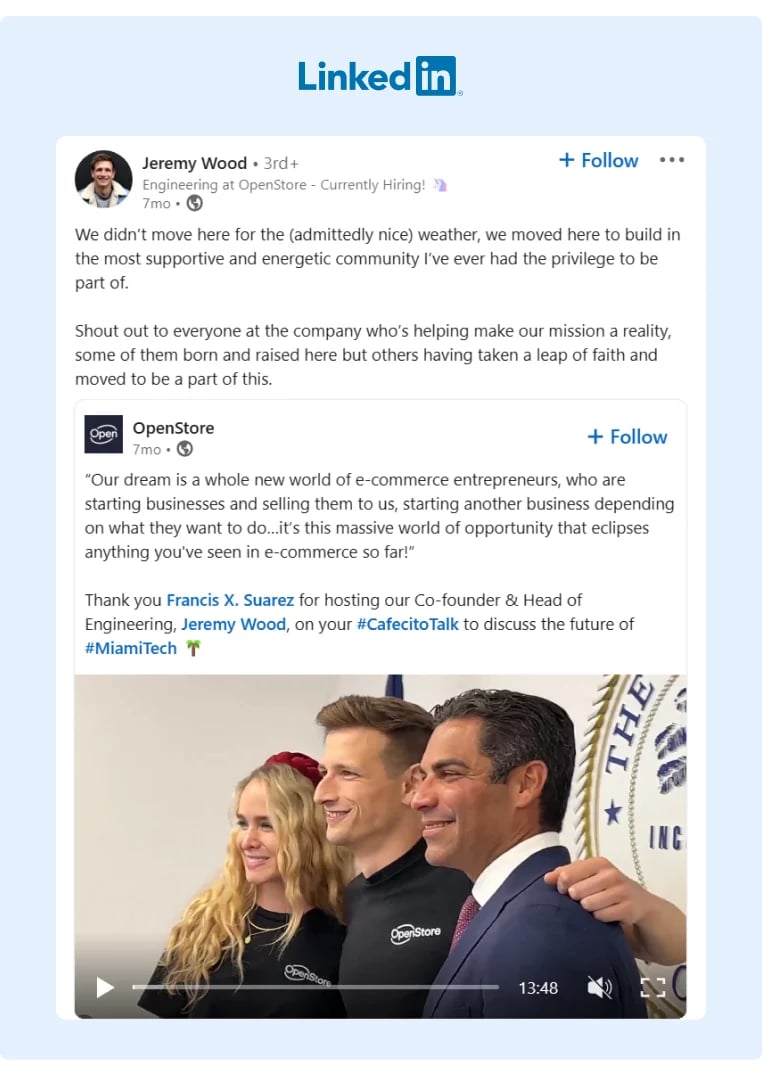
So if employee advocacy is so valuable, why doesn't everyone use it?
Organizing the right employees to share the right content and company initiatives can be a logistical nightmare.
Most marketing managers start by sending mass messages to employees, though those messages inevitably become noisy, and it isn't long before the requests are ignored.
While personally requesting employees to share certain content can help improve engagement rates, it's incredibly time-consuming and usually isn't sustainable.
To solve this problem, we built GaggleAMP.
GaggleAMP makes it super easy to assign engagement activities to specific employees at scale. Here's a brief overview of how it works:
Step 1: Assign an Engagement Activity to Employees
First, you’ll select an engagement activity for the social media platform you want the employee to engage on. We offer engagement activities for all social media platforms and are always adding more.
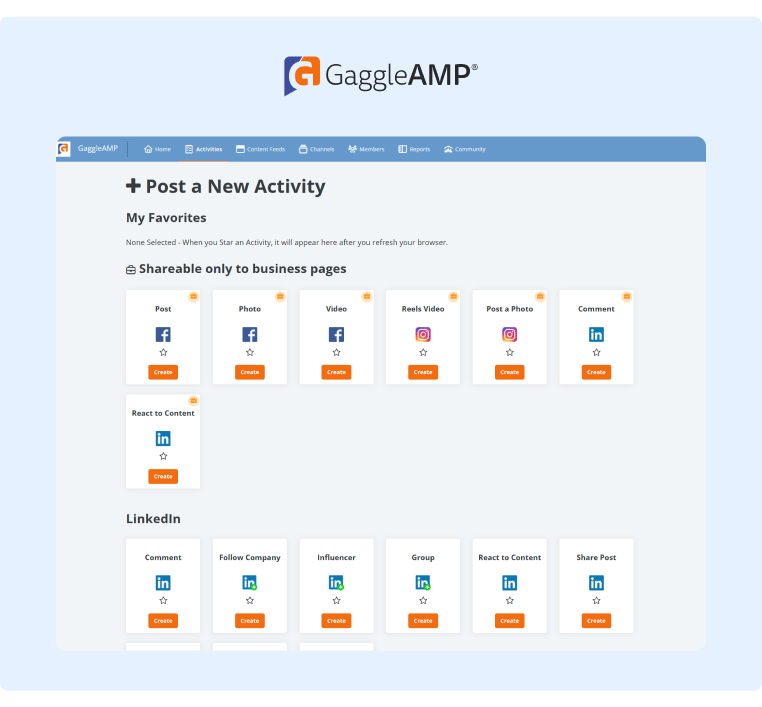
After selecting the engagement activity, you can customize it with specific engagement instructions, set a deadline, and add any other relevant information. Next, you can assign it to either a group of employees (e.g., marketing team, executives, etc.) or select specific employees from a list of those active in GaggleAMP.
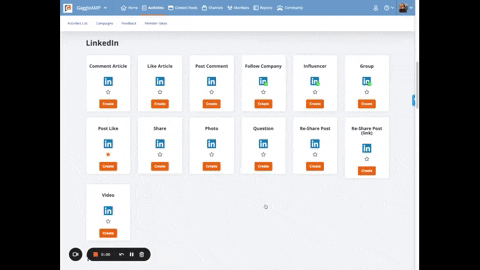
Step 2: Employees Complete The Engagement Activity
Employees receive a notification when you assign an engagement activity (via email, Slack, and/or Microsoft Teams). Then, they can log into the Gaggle and complete the personalized list of engagement activities.
By giving employees a personalized list of engagement activities, employees are more likely to engage because they don't have to sift through a massive feed of company posts to find one that is relevant to their social network.
Once employees complete the activity, they can schedule it to publish at a future date. This is a major benefit for employees because they now only have to dedicate 10-15 minutes to employee advocacy once per week rather than making time several days throughout the week.
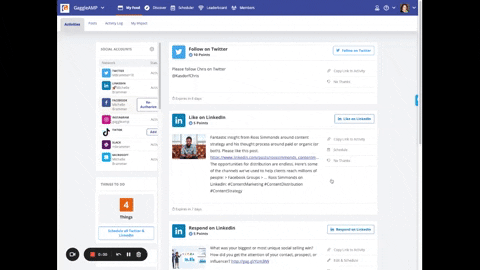
Step 3: Measure Employee Advocacy Efforts
Finally, GaggleAMP makes it easy for you to measure both:
-
Which employees are most engaged
-
The ROI of your employee advocacy efforts
The public leaderboard ranks employees by engagement, which makes it easy for you to finally reward those who are most engaged (and inspire some friendly competition!):
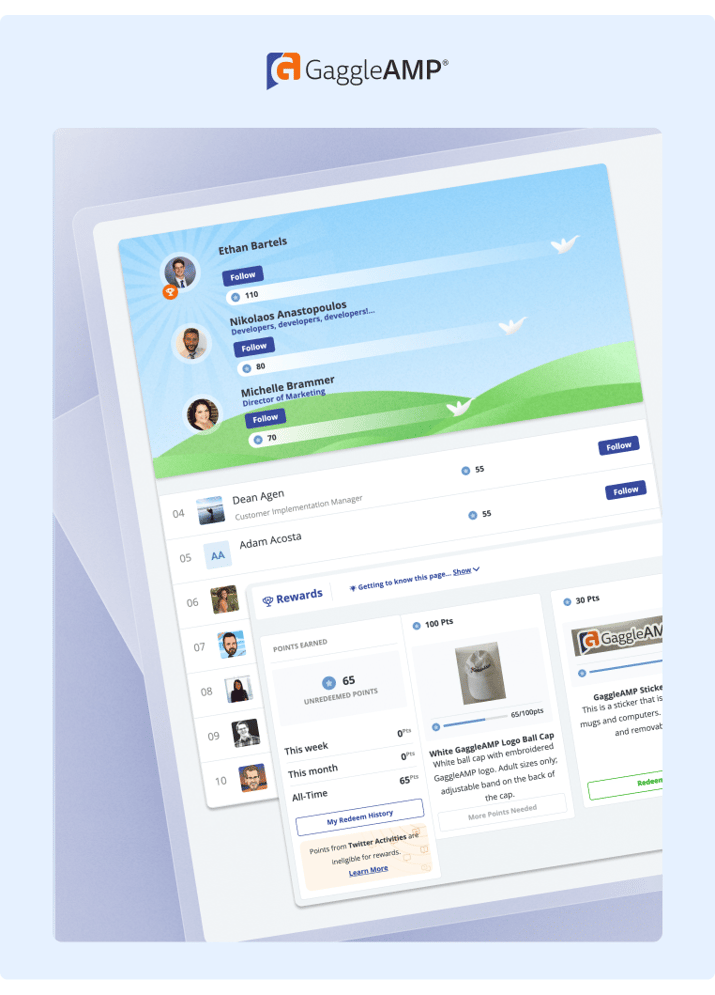
In addition, GaggleAMP also offers an analytics dashboard with estimated earned media value (EEMV), total reach, and clicks so that you can prove the value of employee advocacy to stakeholders.
If you’d like to try GaggleAMP yourself, you can schedule a demo or jump into the platform today!
2. Create Content That Ignites Envy
If your company's LinkedIn profile is filled with job posts, it can make the brand seem desperate and repel the best potential candidates.
So the key to an effective employer branding strategy is to create content that instead inspires a little bit of envy in readers.
To do this, be sure to create posts that emphasize the following:
-
Company culture
-
Employee wins (speaking at conferences, achievements, etc.)
-
Company wins (awards, achievements, etc.)
Archer is an excellent example of a company that inspires envy by discussing what they're working on, the people working on it, and funding announcements/awards won.
Here's a great example of a culture post from Archer:
Here's an example of a funding announcement/achievement style post:
Here's an example of an inspirational "what we're working on" style post:
You can also ask employees to post about what they’re working on at your company as this is yet another way to inspire envy and make people want to work for your company.
Here’s an example of employee advocacy that inspires envy from Archer:
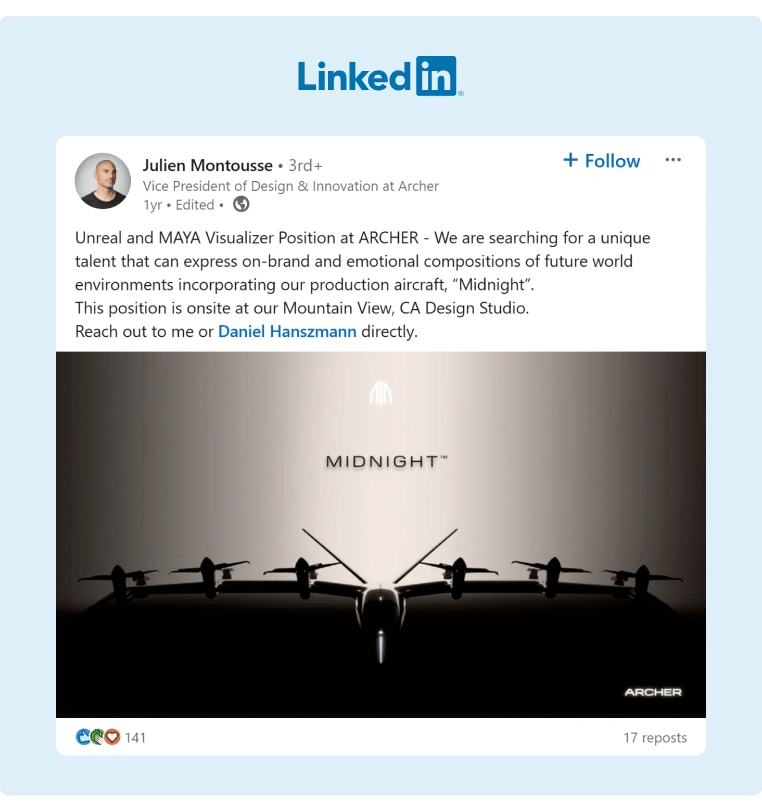
These "enviable" posts lay the groundwork that makes talent acquisition easier because the vision is so inspiring. So if the brand ever does publish a job opportunity post, it would seem like a privilege to work with them as opposed to a desperate brand struggling to fill positions.
Archer is actually a GaggleAMP customer and it’s a key reason why they’ve been able to maintain a sustainable employee advocacy program. To see for yourself if GaggleAMP is a good fit for your company, you can schedule a demo today.
3. Engage With Commenters
Simply engaging with commenters is a great way to improve your employer branding efforts, as two-way conversations help build relationships.
Neil Patel (whose corporate brand, NP Digital, is closely related to his personal brand) does a great job engaging with commenters.
Here's just one example of how he (or someone on his team) meaningfully engages with commenters:
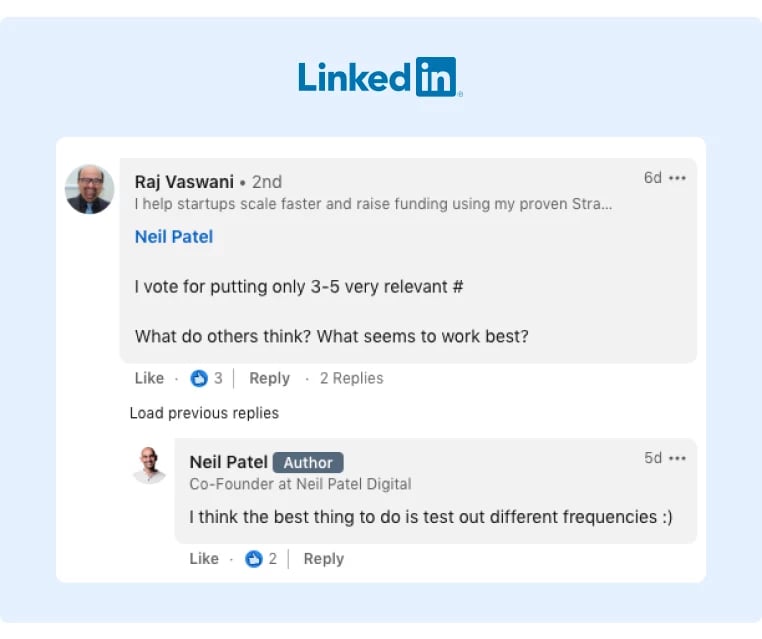
The other benefit of engaging with commenters is that it doubles the engagement on your posts which sends a positive signal to social media algorithms and incentivizes them to give it more organic reach.
It's also worth noting that you don't always have to respond with the LinkedIn company page's account. You can also ask executives to respond to commenters, making the engagement feel more authentic.
Finally, pay attention to when other people mention your brand and join the conversation. This is a great opportunity for you to interact with people that have received a warm intro to your brand.
To identify these conversations, you can use a tool like BrandMentions or Awario to send you an alert whenever someone mentions your brand.
4. Host Collaborations With Influencers
Note that you can also select a handful of executives and help them become industry micro-influencers. If candidates are inspired by ideas your executives voice on podcasts or social media, they are much more likely to apply to your company, as the best talent tends to care a lot about who they work with.
In addition to booking podcasts and guest posts for executives, you can also use a tool like GaggleAMP to help your executives build their personal brand on social media. For example, you can assign the question engagement card and use one of the prompts below:
-
What is one thing that you've learned this week that you think our target audience would love?
-
What's something you love about our company values?
-
What is an opinion you've held regarding an industry topic that has shifted in the past year?
-
What is a common misconception you see about [insert topic]?
-
What is your opinion on (recent industry news topic)?
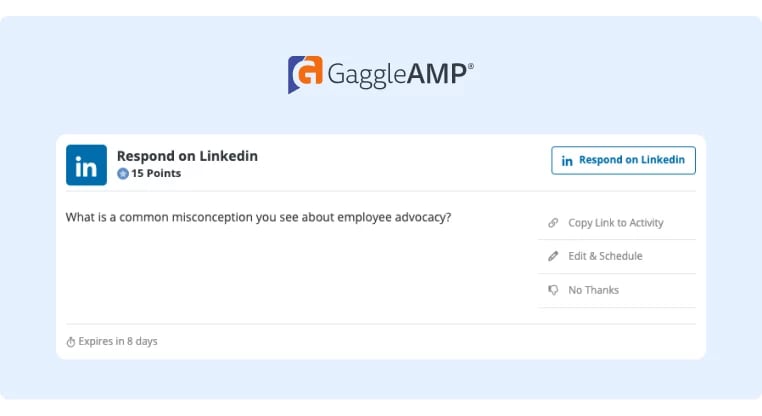
5. Target Your Ideal Audience With LinkedIn Ads
While the tips outlined above are designed to help you build the company’s reputation and highlight its employee value proposition, you can also play offense by targeting your ideal audience with ads.
LinkedIn offers the following targeting options:
-
Locations: The state/country of candidates
-
Audience Attributes: This includes, company information (like connections, category, name, etc.), job experience (seniority, title, etc.), education (school, degree, etc.), demographics (age, gender), interests, and traits
-
Custom Audiences: Retargeting, lookalike, and third-party
You can then run ads to these audiences with job openings and employee testimonials.
If you’re not actively hiring and just want to promote a positive employer brand image, you can run ads to culture posts, announcements, and other content that would interest your ideal candidates and keep your brand top of mind.
LinkedIn also offers a jobs section for each company where you can create a job listing and then promote it. Here’s an example of what the promoted jobs look like to the audience:
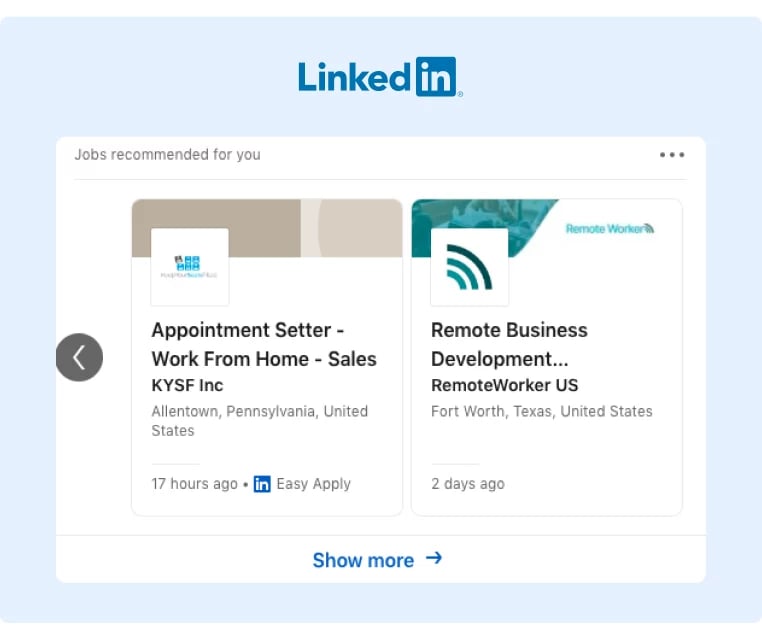
6. Double Down On What Works
While all of the tips in this post are designed to make it easier to attract top talent, you'll still have to do some experimentation to figure out what resonates with your ideal candidates.
So consider surveying your new hires and ask them:
-
Where they first learned about your company?
-
What message resonated with them?
-
What made them choose you over the competition?
Once you see some trends in what's working, double down on that from both a channel and messaging perspective.
Developing an Employer Branding Strategy That Works For You
While LinkedIn Recruiter makes it easy enough to reach out to candidates individually, it’s much easier (and cheaper!) to attract candidates organically with a strong employer brand presence.
So take the tips in this post and implement them to turn your brand into a sought after workplace that becomes a talent magnet.
Of course, a key part of that is leveraging your current employees to promote the brand. It can be challenging to engage your employees at scale, so if you want a tool that makes this process easy and requires just a few minutes per week, schedule a demo of GaggleAMP today.










